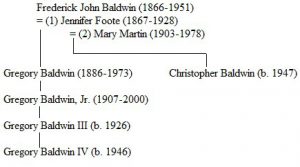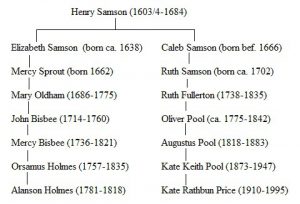 A (non-genealogical) post I read recently involved someone referring to a relative of an older generation as a “second cousin.” I asked further about the kinship, and this person was actually the author’s mother’s first cousin, and thus the author’s “first cousin once removed,” which is a common mistake in kinship assignment. However, it got me thinking about how much “generational spread” can occur even in a comparatively short period of time.
A (non-genealogical) post I read recently involved someone referring to a relative of an older generation as a “second cousin.” I asked further about the kinship, and this person was actually the author’s mother’s first cousin, and thus the author’s “first cousin once removed,” which is a common mistake in kinship assignment. However, it got me thinking about how much “generational spread” can occur even in a comparatively short period of time.
My oldest second cousin was born in 1949 (two years before my father), as my father is the youngest grandchild on his father’s side and this second cousin of mine is the eldest child of my father’s eldest first cousin. My own first cousins, all on my mother’s side, range in birth years from 1970 to 1988; cousins in the next generation were born between 1990 and (to date) 2016.
Significant differences in the ages of generations occur when a male has children later in life.
My wife’s family has even more generational spread. Her mother is the tenth of eleven children, and she has nieces who were born before she was. On this side my wife’s eldest first cousin was born in 1955 and the youngest in 2004 (I think!). My father-in-law is the third of seven children, and the cousins’ birth years range from 1967 to 2015.
Significant differences in the ages of generations occur when a male has children later in life. The example given above (names are changed) concerns a friend’s ancestor who had a first “batch” of children in his twenties. He married again at age 63 and had his youngest child at age 81. In this case, he had great-great-grandchildren born before his youngest child.
Often, when recognizing common colonial ancestors with members, I’ll determine our kinship; it is usually anywhere from ninth to twelfth cousins, zero to four times removed. The generations apart is not often indicative of our actual ages, reflecting a generational spread that occurs over time. Sometimes we are the same generation genealogically but fifty years apart in age. Other times we might be the same age but four genealogical generations apart.
 Using the Mayflower Families for Five Generations series, I looked in the Henry Samson volumes, since this passenger had nine children and these books trace many descendants for seven generations, to see examples of significant generational spread. The following chart might not be the most extreme in these volumes, but represents the varying ages in the same generation.
Using the Mayflower Families for Five Generations series, I looked in the Henry Samson volumes, since this passenger had nine children and these books trace many descendants for seven generations, to see examples of significant generational spread. The following chart might not be the most extreme in these volumes, but represents the varying ages in the same generation.
In this above example, by the eighth generation the spread goes across three centuries, from 1781 to 1910. Does anyone have an example within eight or so generations going across four centuries? I would think this could be possible, if the “senior” line has a birth in the late 1700s, while a “junior” line, made up largely of men having children late in life, could extend to the beginning of this century.
Share this:
About Christopher C. Child
Chris Child has worked for various departments at NEHGS since 1997 and became a full-time employee in July 2003. He has been a member of NEHGS since the age of eleven. He has written several articles in American Ancestors, The New England Historical and Genealogical Register, and The Mayflower Descendant. He is the co-editor of The Ancestry of Catherine Middleton (NEHGS, 2011), co-author of The Descendants of Judge John Lowell of Newburyport, Massachusetts (Newbury Street Press, 2011) and Ancestors and Descendants of George Rufus and Alice Nelson Pratt (Newbury Street Press, 2013), and author of The Nelson Family of Rowley, Massachusetts (Newbury Street Press, 2014). Chris holds a B.A. in history from Drew University in Madison, New Jersey.View all posts by Christopher C. Child →